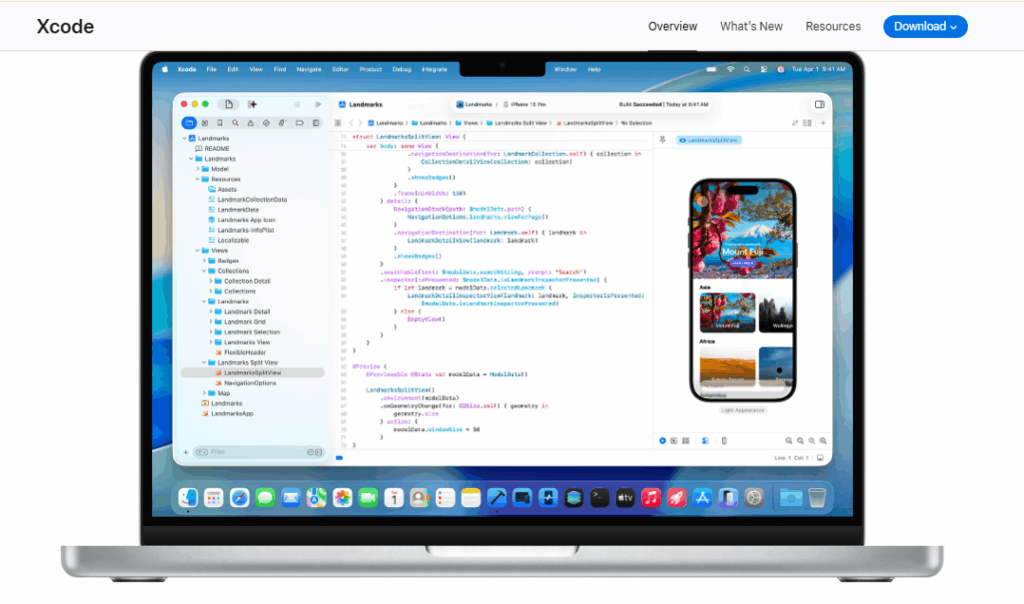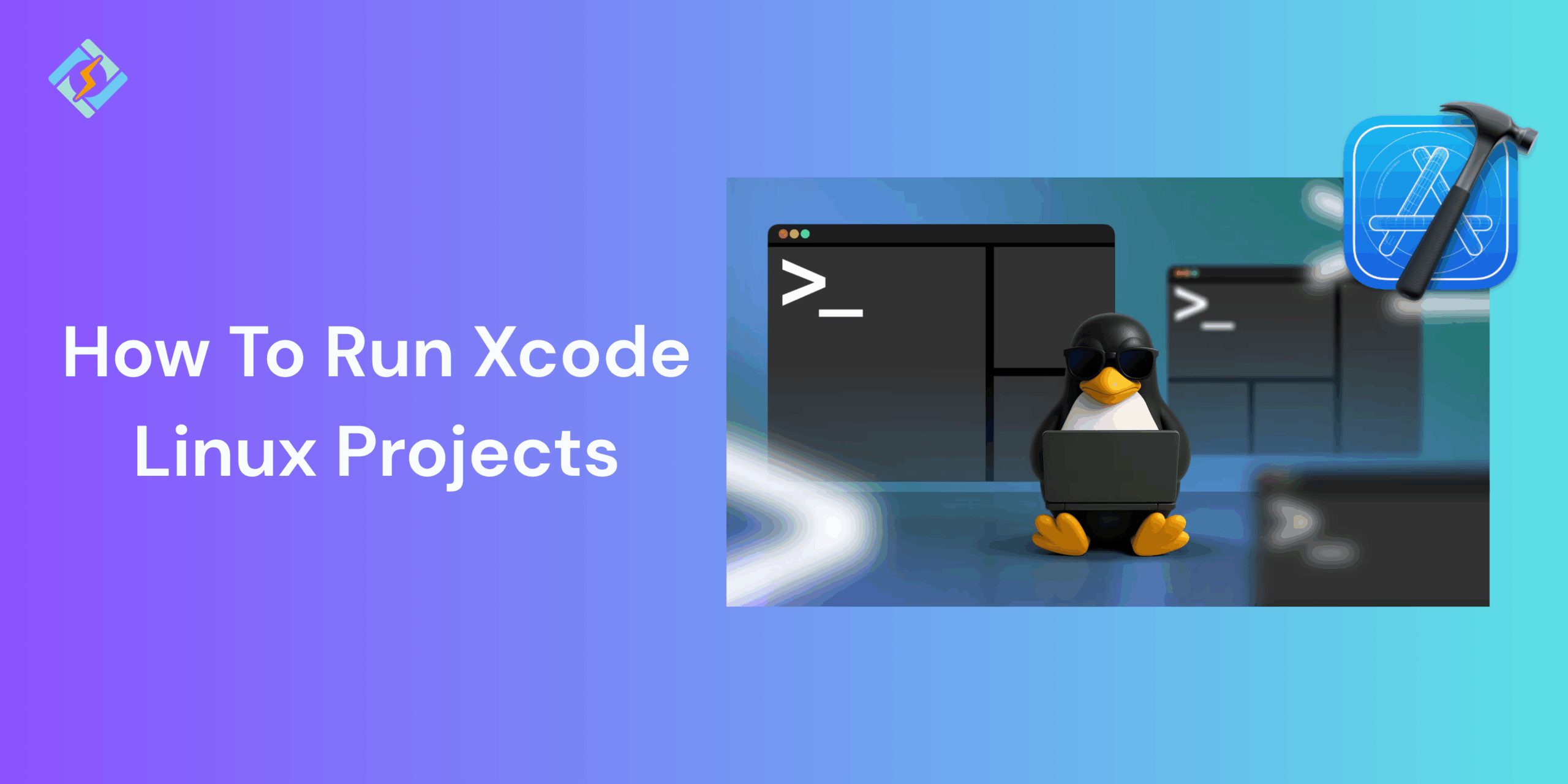A guide to teach you everything about running an Xcode Linux Project, the practical tools, and whereabouts you never knew of.
Why Developers Want Xcode on Linux?
A little background! Xcode was first launched in 2003. Apple frequently provides package updates and continues to issue software updates.
Xcode includes a set of tools that developers use to create apps for Apple platforms. It also allows users to easily manage the entire development process, from creating the app to testing, optimizing, and submitting it to the App Store.
Features Crucial for Developing in the Apple Ecosystem:
- Includes a code editor, debugger, interface builder, and simulators.
- Vital for development specific to products.
- Grants access to the latest technologies from Apple.
- Provides a complete development environment.
Xcode is a macOS Cocoa application, meaning it depends heavily on macOS-specific frameworks and libraries that are not available on Linux. The low-level toolchain, like the GCC compiler family and the GDB debugger, is open-source and widely used across Unix and Linux systems. However, the complete Xcode IDE, which features the editor, project management, and graphical debugger, cannot be used on Linux.
Running Xcode Linux On A Project: Practical Workarounds!

Prerequisites:
Get exclusive access to all things tech-savvy, and be the first to receive
the latest updates directly in your inbox.
Xcode is a software development tool made by Apple that’s:
- a proprietary software designed for macOS and Apple hardware
- An Integrated Development Environment (IDE)
- a collection of tools for creating Apple-related apps
Since it’s closed-source software, we can’t just run the Xcode app on Linux. But the open-source movement is pretty strong in the entire Unix world, which includes both macOS and Linux. So, it’s not surprising that the low-level tools and libraries that help build Xcode are open source.
Even so, the high-level parts of the IDE are proprietary content specifically designed for macOS, and attempting to run the Xcode app directly on Linux would breach the Apple Xcode End User License Agreement.
Darling
Darling is a translation layer that allows Linux users to run macOS applications. At present, Darling supports basic graphical user interface (GUI) apps and some command-line applications. Therefore, we can utilize the Xcode command-line tool through Darling.
Build and Install DarlingFirst, we need to download the required dependencies for our Linux distribution. For instance, let’s download and install what’s needed on Ubuntu:
$ sudo apt-get install cmake clang bison flex xz-utils libfuse-dev libudev-dev pkg-config \<br>libc6-dev:i386 linux-headers-generic gcc-multilib libcap2-bin libcairo2-dev libgl1-mesa-dev \<br>libtiff5-dev libfreetype6-dev libfreetype6-dev:i386 git libelf-dev libxml2-dev libegl1-mesa-dev \<br>libfontconfig1-dev libbsd-devNext, we will clone the Darling git repository to our local machine:
$ git clone --recursive https://github.com/darlinghq/darling.gitThen, we will navigate to the Darling clone directory:
$ cd darlingNow, let’s create a build directory for the build process:
$ mkdir build && cd buildInside the build directory, we will configure the build using CMake:
$ cmake ..Now, we will build Darling using make:

$ makeIt’s important to note that the actual build process may take up to an hour, depending on the resources available on our machine.
Finally, we will install Darling, build the Darling kernel module, and install darling_mach:
$ sudo make install<br>$ make lkm<br>$ sudo make lkm_installAt this stage, we have set up Darling on our Linux system. Next, we will proceed with installing and running the Xcode command-line tool.
Install Xcode on Linux With Darling
To execute a program on Linux using Darling, we first need to access the Darling subsystem and start a macOS shell environment by running the darling shell:
$ darling shellNow, we can execute macOS system commands. Additionally, any further macOS software installation occurs within the darling shell. Therefore, running commands is not possible without connecting to Darling
Finally, we can download and install Xcode command-line tools.
Xcode: Benefits and Cross-Platform Methods
Product-Specific Development:
- Xcode is tailored for creating software for Apple’s platforms.
- It includes tools and frameworks that are optimized for the distinct features of each platform.
Comprehensive Development Environment:
- Xcode Linux provides you with a complete set of tools that encompasses the whole software development lifecycle.
Access to Apple’s Latest Technologies:
- Xcode receives regular updates with the newest technologies and features from Apple.
App Store Submission:
- Xcode makes it easier to submit applications to the App Store.
Cross-Platform Approaches:
- Visual Studio: Microsoft’s IDE facilitates cross-platform applications through Xamarin.
- React Native: Facebook’s open-source framework allows for cross-platform apps using JavaScript and React.
- Flutter: Google’s mobile app SDK enables developers to create cross-platform applications with Dart.
Note: These methods allow the use of non-Apple development environments, but they may not achieve the same level of integration and optimization as Xcode.
Best Alternatives to Xcode Linux Developers
The table shows the top alternatives to Xcode for Linux:
| Tool / IDE | Language Support | Strengths | Limitations | Best For |
|---|---|---|---|---|
| Visual Studio Code | Swift (via extensions), Python, C++, JS | Lightweight, huge plugin ecosystem, works with Swift on Linux | Requires setup for iOS builds | General development & Swift coding |
| CLion (JetBrains) | C, C++, Swift (with plugins) | Great debugging, refactoring, deep project analysis | Paid license (with free trial) | Great debugging, refactoring, and deep project analysis |
| Eclipse | Java, C++, Swift (plugins) | Open-source, strong for enterprise projects | Can be heavy, needs plugins for Swift | Java-heavy projects, cross-language dev |
| Qt Creator | C++, Python, Swift (manual setup) | Strong UI design tools, great for cross-platform apps | Not tailored for iOS/macOS | GUI-based app development |
| Atom (deprecated but forked) | Multiple languages, Swift (community packages) | Customizable, open-source | Deprecated officially, limited support | Lightweight coding in multiple languages |
| KDevelop | C++, Python, Swift (community plugins) | Open-source, fast for C++ projects | Limited Swift integration | Developers working with C++/KDE environments |
Conclusion
For many of you, this might have come as a shock that Xcode Linux can’t be directly installed. But the bright side is that with the right tools and some workarounds, you can still develop Swift, iOS, and macOS projects right from your Linux setup. Whether you opt for virtual machines, cloud-based macOS options, or alternatives like VS Code and CLion, Linux can definitely be part of your Apple development process.
For complete iOS app deployment, you’ll eventually need a Mac at some point, but Xcode Linux will offer you flexibility, speed, and robust development tools to tackle most of your coding needs.
FAQ’S
1. Can you use Xcode on Linux?
No, Xcode is exclusively for macOS. On Linux, you can work with Swift using alternatives like VS Code or CLion, or utilize cloud-based macOS services.
2: What is the top alternative to Xcode Linux?
Visual Studio Code is the leading alternative because of its versatility, Swift support through extensions, and lightweight nature.
3: How can I run iOS projects on Linux?
You cannot completely run iOS builds on Linux by itself. Instead, consider using remote Mac servers (such as MacStadium) or CI/CD pipelines to compile and deploy iOS applications.
4: Is it possible to install Swift on Linux without Xcode?
Yes. Swift is officially supported on Linux. You can install it directly and execute Swift programs without needing Xcode.
5: Is using cloud-based macOS superior to a VM for Xcode projects on Linux?
Cloud-based macOS (like MacStadium or AWS EC2 Mac) is generally more dependable for professional development as it provides genuine macOS environments without the performance drawbacks often seen in VMs.



